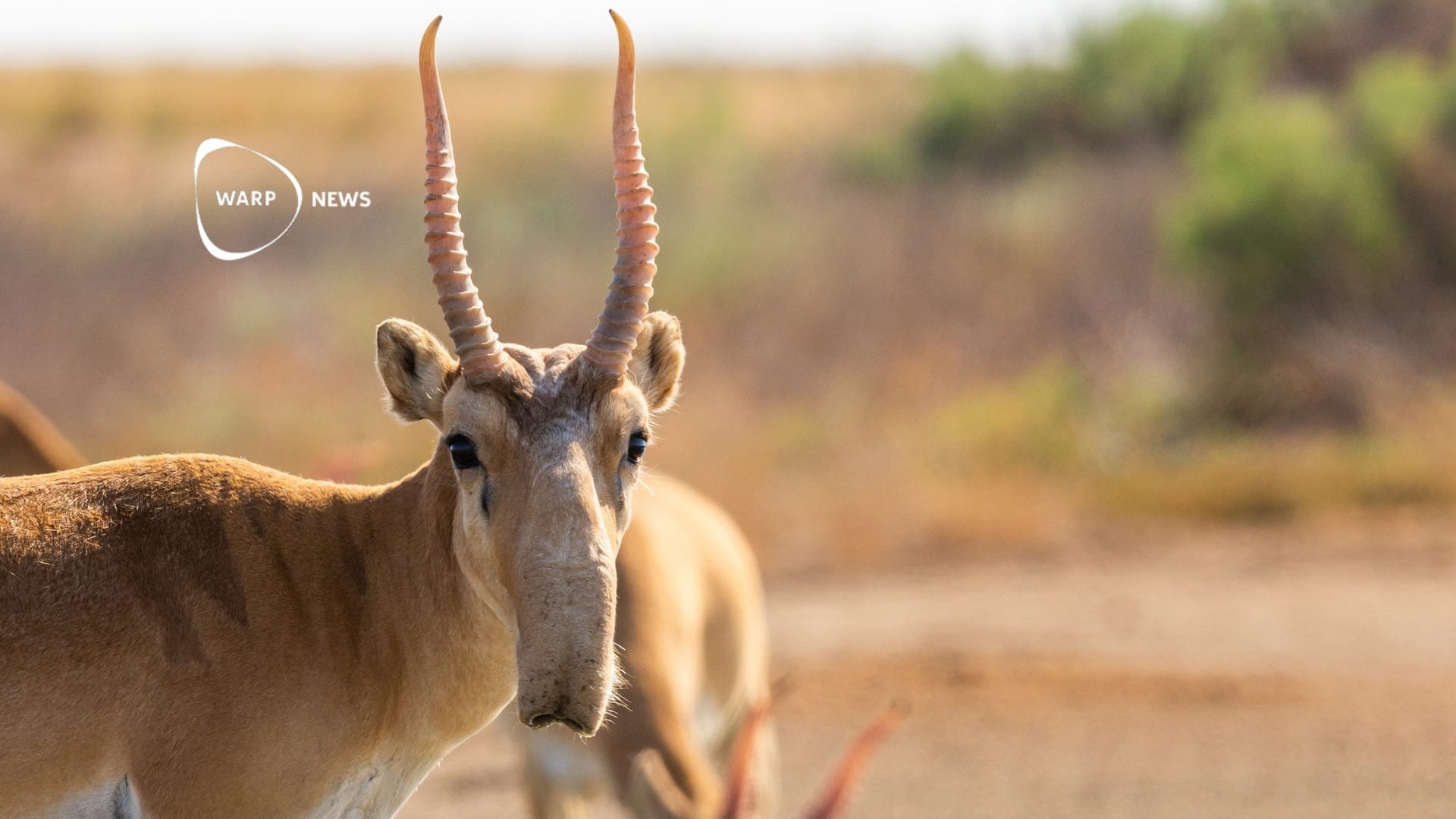
🐯 Investigation: There is no sixth mass extinction going on
"We are entering a sixth mass extinction," says Paul Ehrlich in an interview with Warp News. He is not alone in believing this. But our investigation shows that is wrong. However, there is no shortage of problems with species extinction. But, by and large, we have now learned to manage them.
Share this story!
Thanks to the people in the Warp community who helped us crowdfund this investigation!
Warp News and The Progress Network
This investigation is a collaboration between Warp News and The Progress Network.

The Progress Network is building an idea movement that speaks to a better future in a world dominated by voices that suggest a worse one. They have a weekly newsletter, What Could Go Right?
Warp News also has a weekly newsletter, with fact-based optimistic news on technology, science and human progress.
You can sign up - for free - for both of our newsletters here.
Introduction
"We are in the midst of the sixth mass extinction."
"The sixth mass extinction has begun."
Such statements are repeated so often that they have become accepted as truth.
But they are not true.
There is no ongoing sixth mass extinction.
For many species, the negative trend has been reversed.
However, the issue is complex. The populations of many species have declined significantly, and this is a problem to be taken very seriously. Humans have been responsible for many extinctions throughout history.
Today, we are much wiser, and support for preserving biodiversity is strong. We have learned how to solve the problem and protect the Earth's species.
"Half of all species have already gone extinct"
One of the world's most powerful politicians, with one hand gesturing towards the audience in the conference room – the other hand in his pocket – says, almost in passing:
"Look at what's happening to the species. Half of all species have already gone extinct."

John Kerry is the Biden administration's climate czar, with a seat on the US National Security Council. It was during the Davos meeting in January this year that he made his shocking claim about a massive extinction. He squeezed it in when seeking support for investing twelve trillion dollars in green energy to achieve the 1.5-degree target.
Climate change and species extinction are considered to be related. We will return to that.
We live in a time when humans can influence nature more than ever. We also live in a time when awareness that humans can affect nature is greater than ever.
Concern that we are harming animals and plants more than we should is more the rule than the exception. Perhaps this is mainly the case in wealthy countries, but measurements show that it is a universal human feeling.
In the 1990s, some biologists and agenda setters began to argue that we are in, or are entering, the "sixth mass extinction". The concept is based on the fact that scientists usually refer to five previous mass extinctions in the Earth's geological history, the most recent of which occurred 65 million years ago.
This sixth mass extinction would be, if true, the first caused by humans for natural reasons. One could therefore talk about the first mass extermination.
Are the Earth's flora and fauna closer to collapse than at any time since the dinosaurs disappeared? Is that the direction we are headed? Or is it our increased attention to nature that makes us see it that way? Is John Kerry right when he claims that half of all species have died out?
In this investigation, we will clarify these and other questions about species extinction.
First, we must make one thing clear: Humans have influenced and continue to influence animals and nature, generally negatively. The question is how bad it is, how resilient nature is, and what we are actually doing – and can do – to improve the situation.
We had six hypotheses before our investigation:
- For the past 50 years, species populations are no longer shrinking in wealthy countries. In many cases, they are increasing. Recently, populations have also stopped declining in poor countries.
- What is called species extinction is almost entirely about shrinking populations.
- The extremely large number of species that are said to be continuously dying out comes from theoretical models of insects and even smaller organisms that are assumed to disappear.
- Among larger species, few extinctions in modern times have been truly documented.
- Humans were much worse for animals and nature in the past than they are today.
- Many species thrive in urban environments.
The sixth mass extinction
Let's start with the term that is the starting point for this review, the sixth mass extinction.
According to the prevailing view, fossil finds reveal that five previous mass extinctions have occurred. The first was 440 million years ago. After that, four more occurred at intervals of between 35 million and 145 million years. The fifth is the most famous. That's when the dinosaurs disappeared.
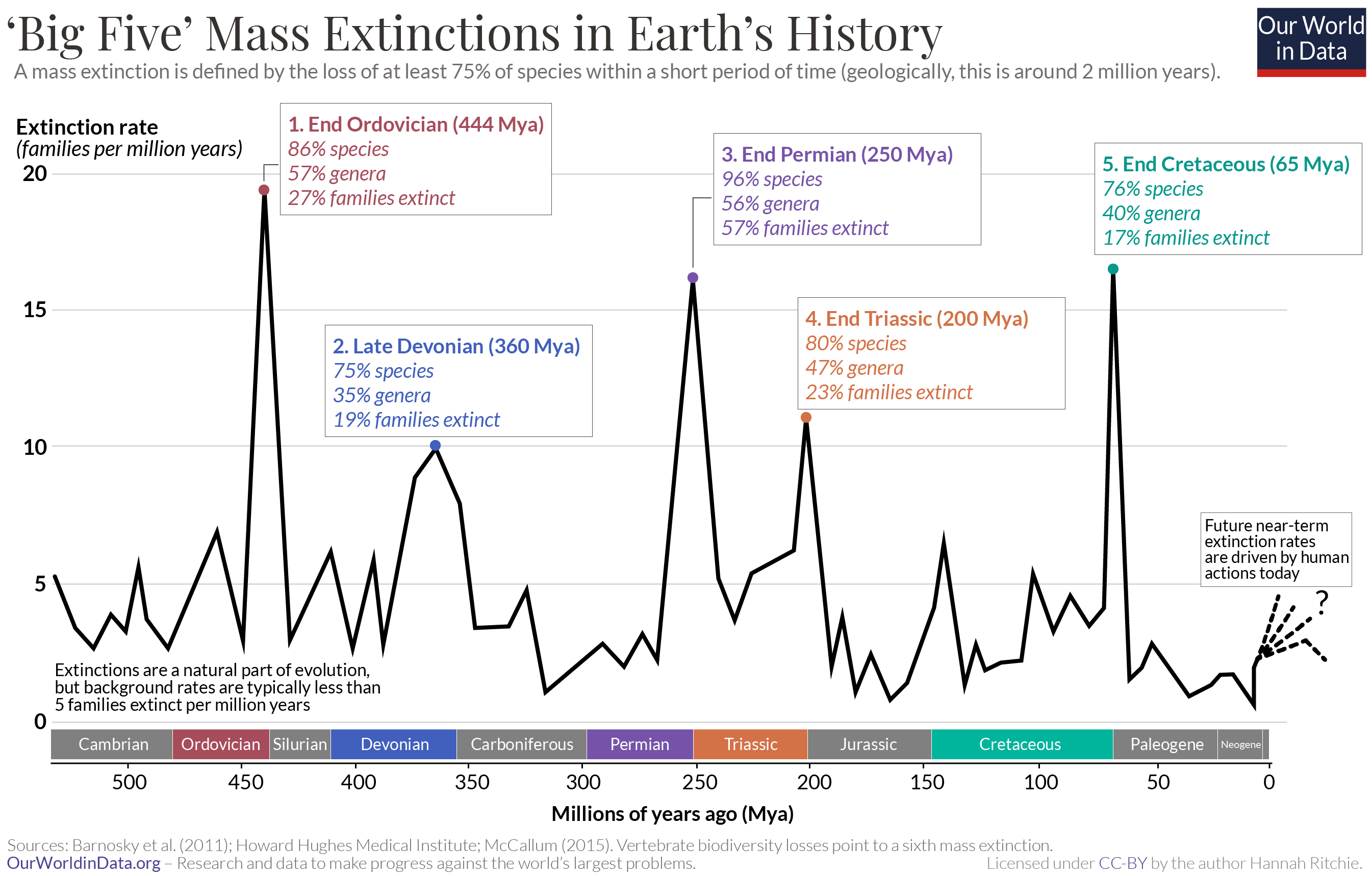
The proportion of species that must die out for it to be called a mass extinction is usually said to be 75 percent. If John Kerry were right, we would not be very far from a "real" mass extinction in a geological sense. But the figure is arbitrary. In fact, between 65 and 90 percent are believed to have died out during the respective collapses. The worst extinction was the third.
That there would have been five such events in the last 500 million years is not set in stone either. Research literature mentions up to 29 possible mass death episodes.
We take a quick look at the conditions before we continue into the winding paths of this topic:
- There are documented cases of extinctions (relatively few).
- There are theoretical cases of extinctions (very many).
- Calculations are made of the extinction rate that should be normal.
- Assessments are made of species populations, which are often confused with actual extinctions.
How many species are there?
No one knows how many species of animals, plants, and fungi there are on Earth. Estimates during the 1980s swelled from 1-2 million to 30-100 million, which was later questioned and scaled down to 5-15 million. Insects dominate.
Just over 2 million species have been scientifically described so far. The vast majority remain to be found, and indeed every year between 15,000 and 18,000 new species are discovered, half of which are insects. If bacteria were included in the calculation, species richness would explode to several billion.
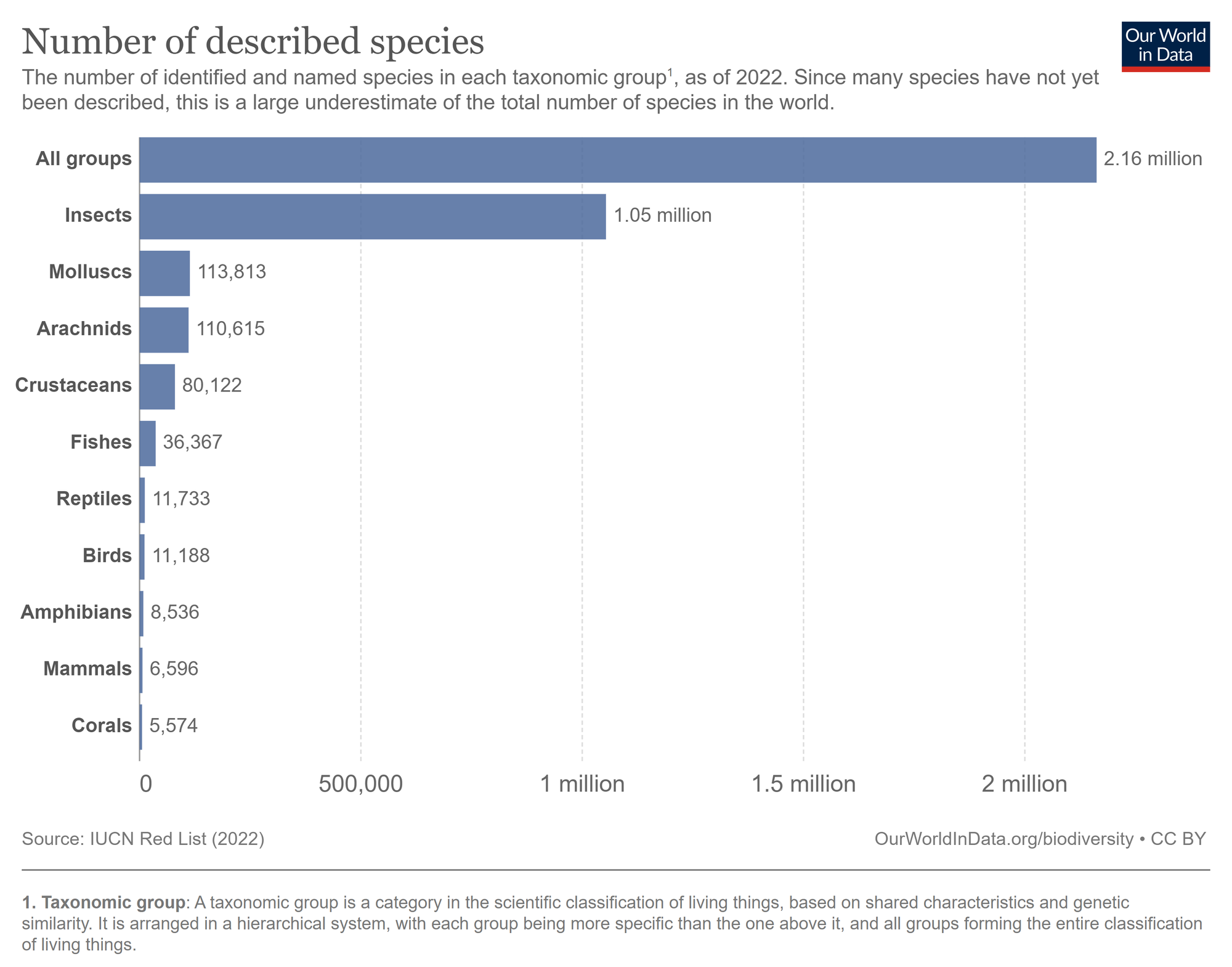
The definition of what constitutes a species is a chapter in itself. How different from its cousin in the meadow does a grasshopper need to be to get its own name according to Linnaeus' binomial system?
The idea that humans are behind a sixth mass extinction may have begun with conservationist Norman Myers' groundbreaking book The Sinking Ark in 1979. He predicted that a million species would become extinct between 1975 and 2000. A decade later, biologist E.O. Wilson followed suit with similarly dramatic calculations of how many species humans drive to extinction. Wilson arrived at nearly 30,000 per year, or around three species per hour, just in the tropical rainforest.
The world's most cheerful pessimist
The alarming figures were embraced by another biologist, Paul Ehrlich, who in 1968 had frightened the world with his and his wife Anne Ehrlich's book The Population Bomb.
"Of course, we are entering a sixth mass extinction," Ehrlich says via Zoom from his home in California.

Paul Ehrlich is a legendary figure in the environmental debate. He is also perhaps the world's most famous pessimist – and possibly the world's most cheerful pessimist. It is a pleasure to meet this charming and sharp 90-year-old, who has just recently published his autobiography, Life.
"I'm an old man now. This could very well be my last words, who knows," says Ehrlich with a characteristic mischievous smile.
You believe we are in the sixth mass extinction?
"It's not a matter of belief. I believe in an evidence-based world, and this is based on scientific work."
Ehrlich explains how the rate of known extinctions since around 1500 has been compared to fossil data that can tell us about the rate between mass extinctions.
"It turns out that the rate today is about 1,000 times higher than for most of our evolutionary history."

In a 2020 study, Ehrlich, along with colleagues Gerardo Ceballos and Peter Raven, assesses nearly 30,000 vertebrate species and finds that 515 of them (1.7 percent) are on the brink of extinction, with fewer than a thousand individuals remaining. The three researchers assume that the majority of these 515 species will disappear "soon."
Paul Ehrlich speaks passionately about how species going extinct disrupts the balance and thereby creates health problems for humans, such as the spread of new diseases. He also talks about how the number of insects has dramatically decreased since he was a young researcher.
But what you are talking about now is not extinctions but reduced populations?
"What is critical for us humans is not species per se but populations. If the pollinating bee were to disappear from North America, it would mean an economic cost of 20 billion dollars per year and significant consequences for our diet. But the bee would still thrive in Southeast Asia and Africa."
Aren't people's attitudes more eco-friendly today than in the past, even if many are not well-informed?
"Yes, I think that's true. But they are ignorant because we don't teach the right things. And 50 percent of all our problems are due to us being too many."
Here, Ehrlich touches on the thesis that has been his signature since The Population Bomb.
"A sustainable number would be between 3 and 3.3 billion people living at the Mexican standard. Now 8 billion are trying to live at the Hollywood standard. That's why biodiversity is disappearing."
"A resource we will never run out of is morons," he says sarcastically, addressing those who have questioned over the years that the Earth's population is too large.
But the number of children per woman has plummeted from 5 to 2.4 since the 1960s?
"That's true and good news. But we are still too many."
What do we know for sure?
If the dramatic numbers Myers, Wilson, Ehrlich, and others have spread are theoretical, what do we know for sure?
Naturally, we have a better grasp on species that are larger and more prominent than insects and obscure fungi. The most comprehensive and reliable source in this context is the International Union for Conservation of Nature (IUCN)'s Red List.
According to this, over the past 400 years, a little over 800 species have gone extinct, or around 900 with the definition of extinct in the wild. The number is actually not easy to come by. It is not something the IUCN advertises.
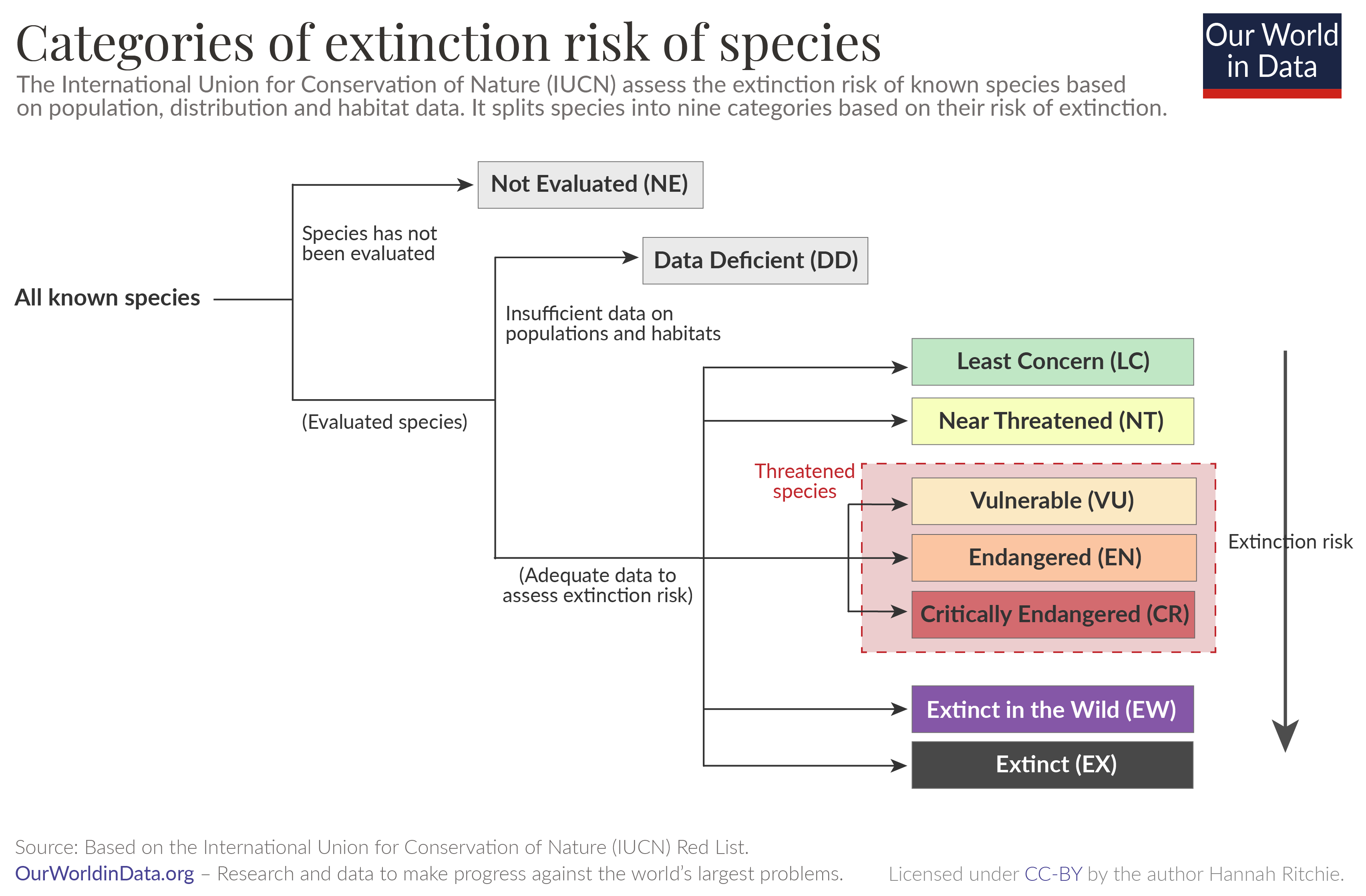
Of the 44,000 known vertebrates, about 350 have disappeared, which corresponds to 0.8 percent. Clearly fewer extinctions among plants have been documented than among animals.
According to the IUCN, over 9,000 species are currently critically endangered, meaning their populations are considered critically small. This is 6 percent of the 150,000 species IUCN has assessed so far, but this total number constitutes only just under 8 percent of all scientifically assessed species, and 3 percent of all species that, with a conservative estimate, are believed to exist.
A prominent critic
Myers and Wilson were challenged by some colleagues, with marine biologist John Briggs being perhaps the most prominent critic. Before he passed away a few years ago, Briggs published over 150 scientific articles and six books.

In a 2016 article, Briggs made short shrift of not just Myers and Wilson but also Al Gore, Richard Leakey, and Roger Lewin, who had all made estimates of between 17,000 and 100,000 annual extinctions. In the past 50 years, Briggs wrote, "a wave of propaganda" of exaggerated numbers and talk of an impending sixth mass extinction has washed over us "making the public feel guilty."
Briggs came to completely different numbers. He was skeptical of the calculations on the "background rate" of extinction that prevailed several million years ago. His own analysis suggested that humans are responsible for 1.5 extinctions per year beyond what can be considered normal. This loss is also likely offset by the concurrent formation of new species, he argued.
John Briggs also pointed out that the studies done on plants have barely shown any decrease in diversity, which is rarely acknowledged.
"Without evidence of a significant net loss of species, mass extinction is merely speculation without substance," he wrote. At the same time, it should be noted that he was very concerned about shrinking populations: "That is the world's major conservation problem."
When I ask Paul Ehrlich about John Briggs' criticism of the mass extinction idea, Ehrlich responds:
"Well, scientists can have different opinions. And I could be wrong. But if I'm wrong about the population, I share that mistake with a bunch of Nobel laureates."
Another researcher involved in the mass death discussion in the early 1990s was W.V. Reid. He took a more cautious stance than Myers and Wilson and did not want to mention any numbers. However, he estimated that 4-8 percent of tropical rainforest species would disappear within 25 years at the deforestation rate in 1992. That time limit has now passed, but no one can know if he was right.
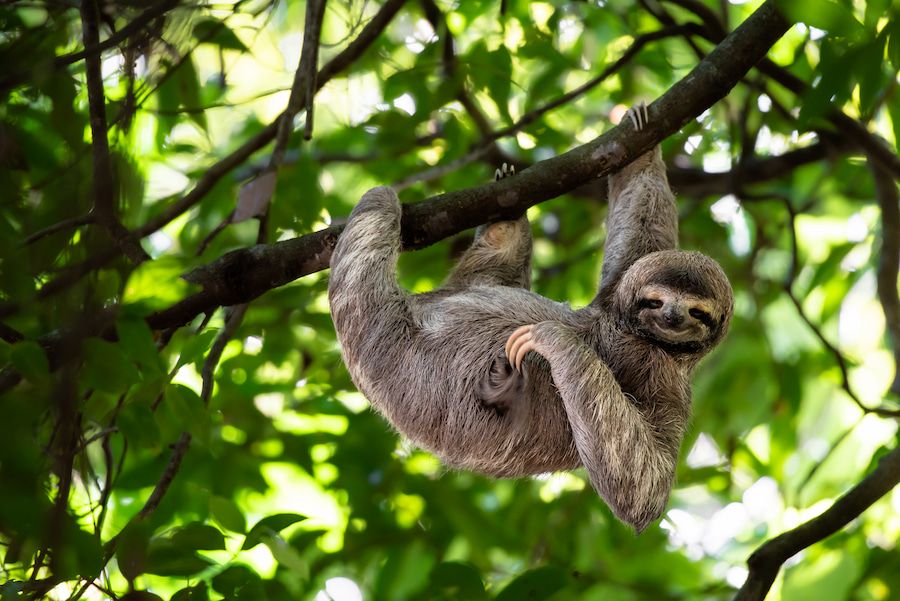
Twenty years after Reid, Australian ecologist Nigel Stork also concluded that the often-referenced figures of tens of thousands of lost species annually are not reliable.
"There is essentially no empirical data to support estimates of 100 extinctions per day, or even 1," Stork writes in a study.
The criticism of mass death that made headlines during the 1990s came primarily from non-biologists. Perhaps the most well-known was economist Julian Simon, who had previously bet with Paul Ehrlich - and won - on how the price of raw materials would develop (but that's another story). In turn, Julian Simon found a friend in political scientist Bjørn Lomborg, who first gained attention for his book The Skeptical Environmentalist in 1998. In it, he claimed - citing ecologist Ariel Lugo and conservation organizations - that no known bird species had disappeared from Brazil's Atlantic rainforest, despite 90% being deforested, and that almost none had disappeared from Puerto Rico, despite 99% of the island's forests being cut down.
"Lomborg is full of sh-t"
"Bjørn Lomborg is full of sh-t," says Stuart Pimm bluntly via video link from South Africa, where he is involved in a project to save species by creating wildlife corridors.
Pimm is a world-leading name in biodiversity research. The highly productive professor of ecology could also be called the leading pragmatist in the field.
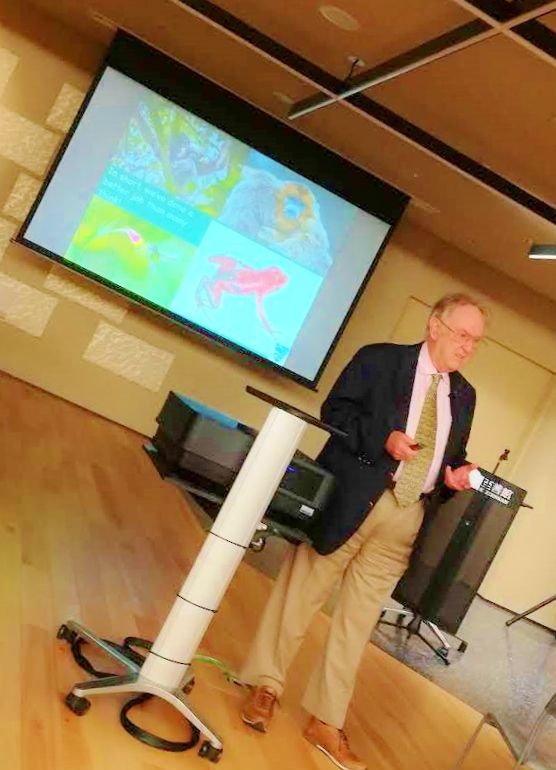
He soon slightly modifies his statement by saying that Lomborg is careless.
"It's simply not true that bird species didn't disappear from the Atlantic rainforest. We know which ones, and the number is consistent with how many species should disappear when calculating it."
Stuart Pimm highlights something very central, yet little noticed, in the debate about how much humans threaten other species: that the greatest diversity does not and has never existed in the areas humans exploit the most.
In a scientific article titled We Can Have Biodiversity and Eat Too, Pimm draws precisely the conclusion contained in the title: we can continue to produce food while maintaining biological diversity. Intuitively, one might think that increased food production should always compete with nature.
"But that feeling is actually wrong, because we mainly don't produce our food where species richness is found," says Pimm.
Agricultural land is growing slower than many think
Land used for agriculture has not by any means grown at the same pace as more food and more people. Since 1970, the Earth's population has increased by 122 percent, but during that time, the cultivated area has only become 8 percent larger. Food is being produced more and more efficiently.
"Yes, that number is very interesting. Not many people know about this."
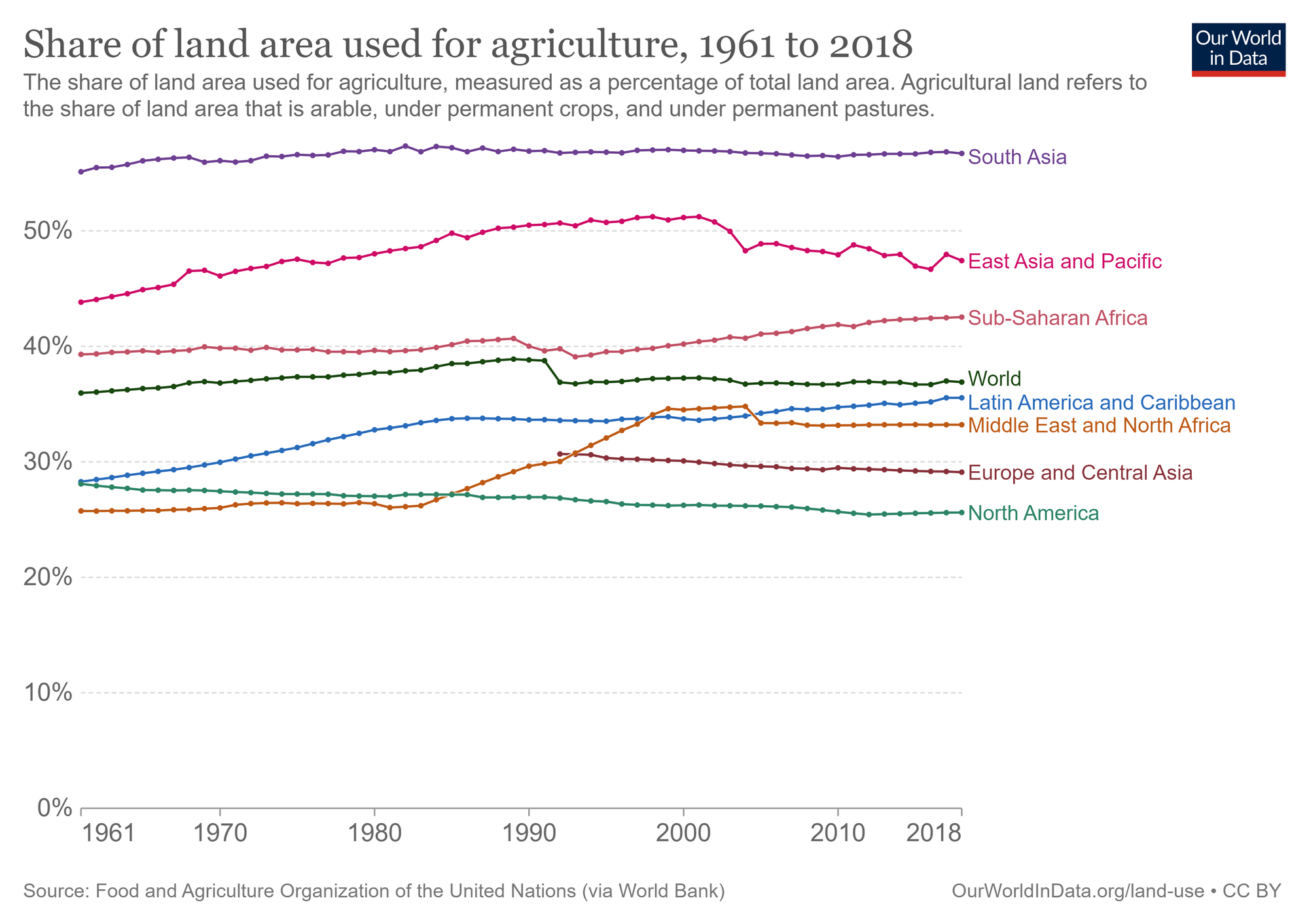
The challenge, according to Pimm, is primarily to create alternative livelihoods for poor people whose activities today may put pressure on species-rich areas.
Stuart Pimm does not think it is a good idea to talk about a sixth mass extinction.
"It is not helpful. Saying that we will lose a million species makes good headlines, but it is not good science. It is based on the assumption that we know how many species there are, and we do not. And how do you define mass extinction?"
He notes that Ipbes, the biological diversity equivalent to the UN's climate panel, does not use the term in its latest report.
"It is very difficult to compare what is happening now with what happened 60 million years ago when the dinosaurs went extinct."
There is no doubt that the rate of extinction is much higher than it would have been without humans. Stuart Pimm is clear about that, and he explains how it can be calculated. But not only are we far from a mass extinction, we also do not know where the rate is heading.
Is there a natural balance between humans and other species on Earth?
"I've written a book titled The Balance of Nature? - with a question mark at the end. So no, there is no obvious simple balance. It's a complicated process."
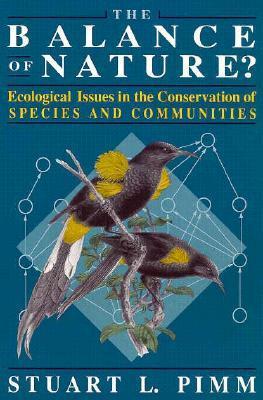
"We are a part of nature. We have to figure out how we can live with nature without destroying it. I'm sure we can do that."
Hypotheses and results
Hypothesis: Among larger species, few extinctions have been documented in modern times
- Generally true. The terms "few" and "modern times" need to be defined more precisely. In geological terms, even what we see as "few" (less than one percent of all vertebrates in 500 years) is a high rate.
Hypothesis: The extremely large number of species said to be continually dying out, comes from theoretical models of insects and even smaller organisms that are assumed to disappear
- True. Since Norman Myers' book The Sinking Ark from 1979, there have been attention-grabbing assumptions that tens of thousands, perhaps even more, species go extinct each year. These figures are impossible to verify.
What about the hotspots?
Biologists and zoologists talk about particularly species-rich "hotspots", such as Madagascar and the tropical Andes. They make up only two percent of the world's land area but house 50 percent of all plant species and 70 percent of all vertebrate species.
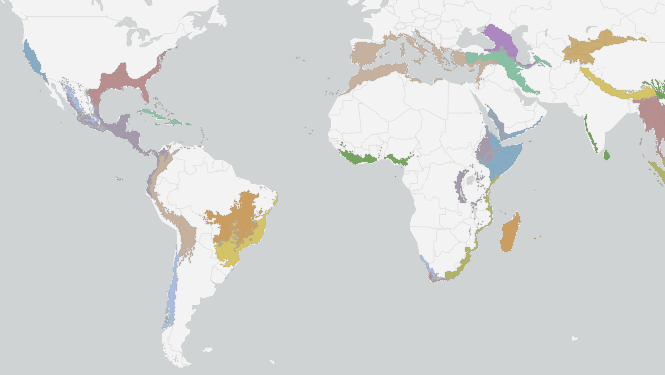
Heavily exploited agricultural land is likely the most devastating environment for biodiversity. However, it is not the case that animals and plants are unhappy in all areas carved out by humans. We no longer primarily live in rural areas. More than half of us now live in cities, and the proportion is expected to be 70 percent by the middle of the century. More and more research is being done on species that thrive in cities, and more and more scientists believe that cities can play an important role in saving parts of biodiversity.
In many of the world's major cities, one can spot animals such as raccoons, wildcats, bears, pumas, sea lions, beavers, owls, and eagles. I myself live in Stockholm and can testify to how deer, hares, and even foxes roam the suburbs as if they have never lived anywhere else. Occasionally, a roe deer or moose appears on a street. Above, sea eagles soar and ravens croak.
This investigation is a collaboration between Warp News and The Progress Network
You can sign up - for free - for both of our newsletters here.

In cities, there are gardens, parks, plenty of food, and often a lot of open water, and no one is hunting – except for the predators who have also sought out streets and squares because their prey has done so.
In Australia, a few years ago, researchers identified 39 endangered species that only live in limited urban habitats, including trees, shrubs, a turtle, and a snail. One study found that of 529 surveyed bird species, 66 were found only in cities. Another study showed that cities can act as a refuge for bees. The coyote has successfully adapted to urban life in the United States. The canine has become excellent at avoiding humans while hunting squirrels and rats in green areas.
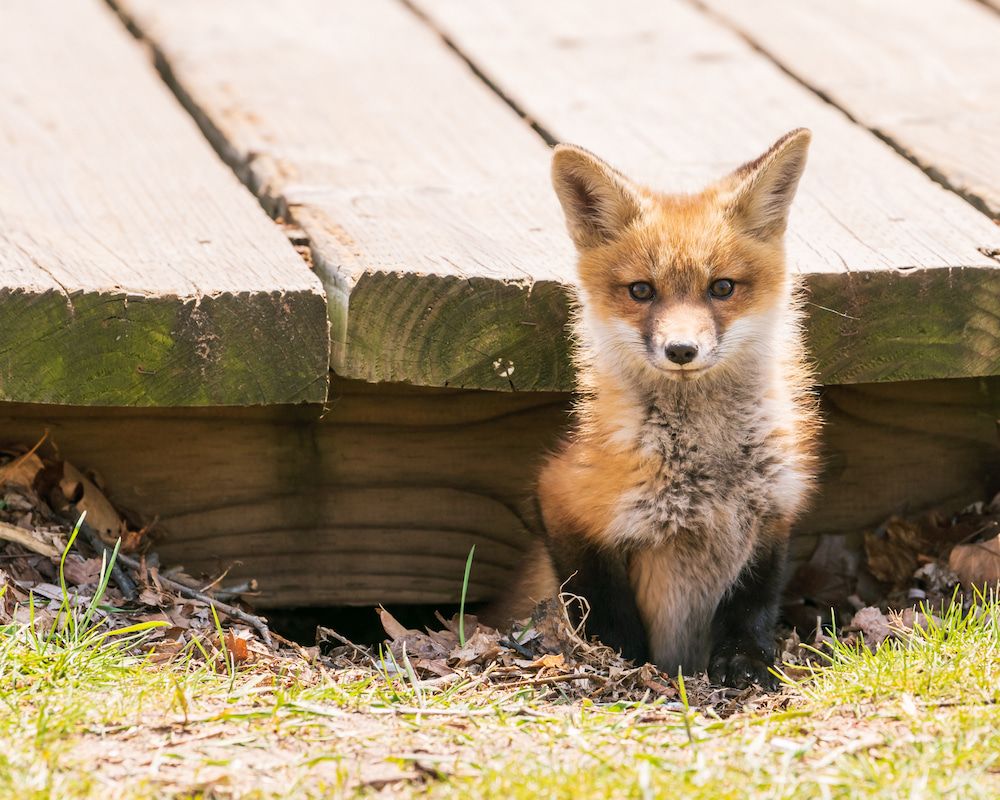
Urban species gradually change their behaviors. It is evolution in real-time. One example is that cities are warmer than their surroundings (a dilemma in climate research), and it has been documented how some urban species have adapted to tolerate higher temperatures than their relatives in the surrounding nature.
Of course, these findings do not mean that all species can thrive in cities. Urbanization pushes away animals and plants with needs for open landscapes, dense forests, and other specific habitats. The point is that something that intuitively should be harmful to all nature works excellently for some parts of it. The matter is not that simple.
Hypothesis and result
Hypothesis: Many species thrive in urban environments
- True. There are a number of studies showing that many animals and plants have successfully made cities their habitats.
"One to two species per minute"
Environmental organizations and journalists have continued to cite Norman Myers and E.O. Wilson's figures. When I wrote about the subject 15 years ago, I called up Greenpeace, asked about the extinction rate, and received the unequivocal answer "one to two species per minute." This referred only to the result of deforestation in the rainforests. That rate corresponds to half a million to a million species per year. If that were true, there would have been no life left in the Amazon for several years.
Today, Greenpeace makes several references to Paul Ehrlich’s work on its international website, and there is even talk of an ongoing ninth mass extinction. On its Swedish website, the organization says that a million species are at risk of extinction, which is in line with what Ipbes states.
The World Wildlife Fund (WWF) takes a slightly lower profile than Greenpeace and writes on its international website that ”experts now believe we’re in the midst of a sixth mass extinction”.
Living Planet Index
WWF is often noted for its Living Planet Index. It is an annually recurring and widely cited report on the real core of the extinction discussion, namely the status of various species' populations, specifically 32,000 vertebrate species. Media and environmental agencies usually report on the document in terms of species extinction, sometimes accelerating species extinction.
According to the latest report, the populations of the surveyed animals have decreased by 69 percent since the starting year of 1970. This is an alarmingly high figure. However, the interesting thing is that the number has been roughly the same for the past decade. This means that the decline in populations has leveled off. Is this true everywhere? Almost.
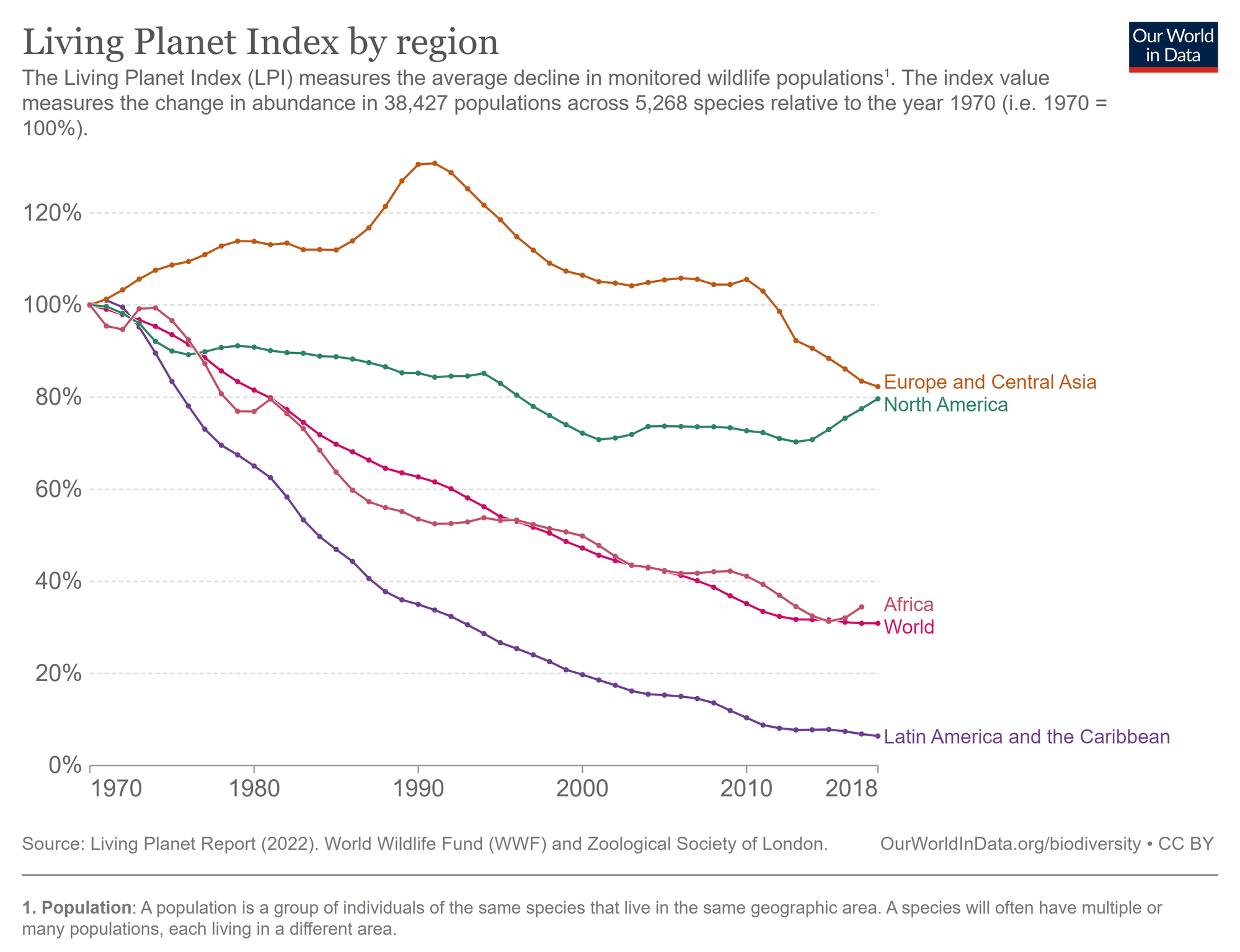
The differences between parts of the world are significant. The largest collapse has occurred in South America and the Caribbean. There, populations are estimated to have decreased by a whopping 94 percent since 1970. This is the only region where the number is higher than the global average. The South American collapse was largest during the 1980s. In recent years, the curve has been almost flat. With such drastically reduced populations, the decline cannot be as steep.
In Africa and North America, however, a small but noticeable increase has been observed over the past five to ten years, and in Asia and Oceania, populations have been stable since 2010.
Europe is combined in the WWF report with the entire Asian part of Russia and Central Asia. In this vast region, populations actually increased from 1970 until around 1991. After that, a downward trend is visible, which in the latest report indicates a decline in populations of 18 percent compared to the base year 1970. However, since the peak in 1991, the decline is at least twice as large. It is unclear what the figures look like for Europe alone (but we will soon tell you about the situation for mammals in this continent).
The above discussion concerns vertebrates, which are a small minority. Invertebrates, especially insects, are believed to make up 97 percent of all animals on Earth.
Six years ago, a German insect study set off alarm bells. It revealed that the number of flying insects at nature reserves in western Germany had decreased by three-quarters in 30 years. Declines in butterflies and bees, among others, have also been described.
However, it turns out that the insect decline is not easy to understand either. A comprehensive meta-study published last year, examining 900 sites worldwide, shows that the relationships between different species, regions, and time periods are weak. In other words: different insect species can increase or decrease in the same area, trends may be opposite in different areas, and a decline during one period can be followed by an increase during another.
In another global study, the same research group discovered that it is land-based insects that have declined. Freshwater-based insects, on the other hand, have increased at least as much. Both of these changes are driven by strong trends in North America and parts of Europe.
What about the climate?
Then there is the issue of climate. Since the question of climate change came up on the global agenda in the early 2000s, it has been almost automatically linked to species extinction - just as it is now linked to all sorts of problems on more or less reasonable grounds.
How well-founded is the claim that the warming we have experienced has caused various species to decline or become extinct? Not at all. It is based on theoretical models. Few, if any, smoking guns have been found. A 2017 study claimed to show that 700 species are already affected, but upon closer examination, it is based on a model of how these species should be affected by the warming observed so far.
Last year, marine biology star researcher Danielle Dixson at the University of Delaware was exposed for fabricating results in several studies on how tropical fish are affected by increased carbon dioxide levels. Her work has been cited in numerous other studies and has made headlines over the years.
It is actually somewhat backward to say that a warmer climate is solely a threat to biodiversity. Earthly life thrives better in heat than in cold. This is a biological fact. Species richness declines dramatically from the equator towards the poles. Tropical rainforests harbor half of the world's plant and animal species. Most species can be traced back to the tropics, including Homo sapiens.
Four times more polar bears
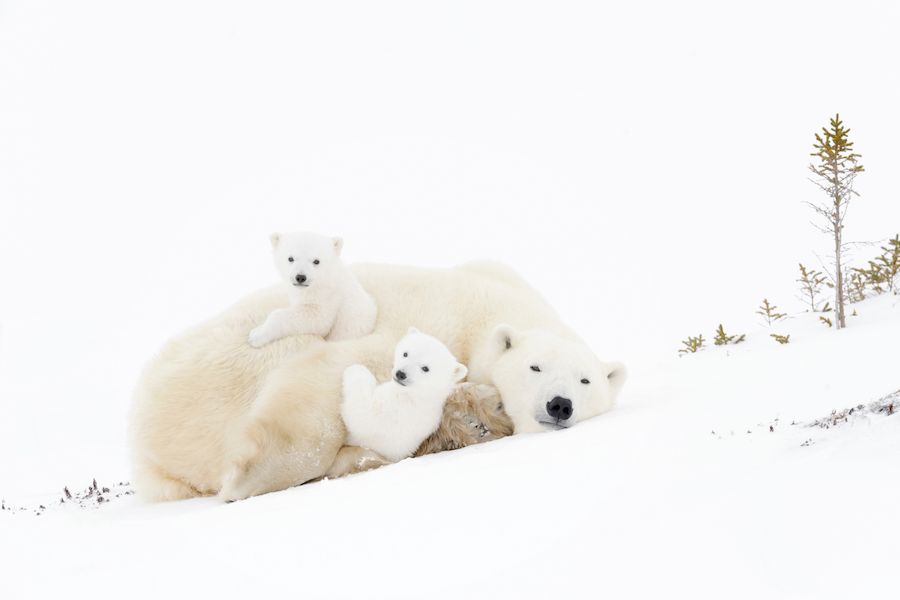
Twenty years ago, the polar bear was the emblem of climate change concerns. Shrinking polar ice (and it has shrunk) would drive the animal to the brink of extinction.
However, the emblem is no longer usable.
It is evident that the bears are doing better than they have in a long time. They are at least four, and according to some estimates, eight times more numerous than they were 60 years ago.
It is also interesting to note that arch-pessimist Paul Ehrlich, in the interview for this article, does not highlight climate change in his indictment against humanity.
Hypotheses and results
Hypothesis: What is called species extinction is almost entirely about shrinking populations.
- Largely true. Media, environmental agencies, and even some researchers often describe reduced populations in terms of extinction.
Hypothesis: For the past 50 years, species populations have stopped shrinking in wealthy countries. In many cases, they are increasing. Recently, populations have also stopped declining in poorer countries.
- Not entirely true. Populations stopped shrinking only about a decade ago in most regions, but not all.
Humans at center stage
In conservation circles, paradoxically, humans often take center stage as the primary source of threats. This goes back far into the vaguely known geological history.
Starting around 50,000 years ago and until about 12,000 years ago, over 200 large mammal species, known as megafauna, went extinct. The extinctions occurred initially in Australia and later in the Americas.
Biologists who have examined these species collapses see a correlation between these events and the established timeline of human arrival in various continents. They, therefore, conclude that our ancestors were responsible for the mass deaths through unsustainable hunting and environmental impacts. Estimates suggest that there may have been a million people worldwide when the ice age ended 12,000 years ago. They had spears and bows and arrows.
The overkill hypothesis
The "overkill" hypothesis has been controversial since Paul Martin introduced it in 1960, but many researchers still take it seriously. However, several practical objections can be raised against the idea that hunter-gatherers would have focused so heavily on killing the largest animals and been so devastatingly effective. There are plenty of indications that speak against the hypothesis.
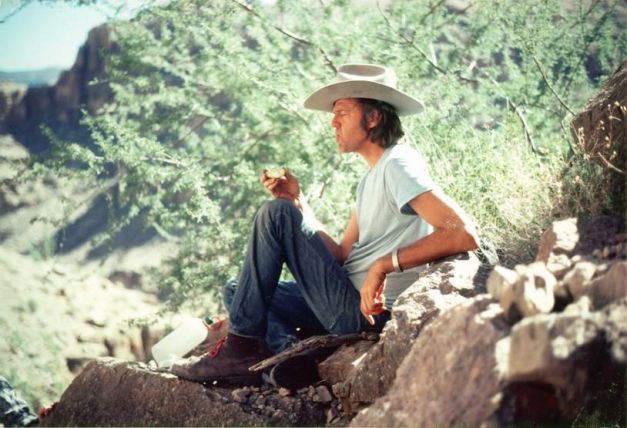
"I think it is taken too literally. I don't think it's so much about a few thousand people actually hunting all these species to extinction, but human presence triggered a series of critical environmental changes," says Tobias Andermann, a researcher at the Department of Organism Biology at Uppsala University.
Andermann is the lead author of a study that concludes that it is humans, not climate change, that has been the primary culprit behind mammalian extinctions over the past 126,000 years.
"We see a strong correlation between population size and extinctions. They almost perfectly follow each other."

Tobias Andermann explains that as certain species declined or disappeared, it may have had knock-on effects on ecosystems, leading to other species dying out. At the same time, human activities had other large-scale effects on ecosystems, such as altering habitats through the practice of setting fires for land use.
"The point is that human pressure on ecosystems occurs in different ways, not just through direct hunting."
It is worth noting that several new findings are beginning to erode the previously established idea that humans arrived in America as recently as 13,000 years ago (the ”Clovis First” theory).
Is earlier climate change the answer?
The primary alternative explanation is usually summarized as climate change. What caused these changes in turn is a question within the question, but hypotheses include comet impacts, solar flares, and violent seismic activity (or a combination), especially during the Younger Dryas, the period that abruptly ended the ice age and coincided with the disappearance of megafauna in the Americas.
There is geological evidence of enormous, worldwide forest fires, and the rapid melting of the ice sheets would likely have caused massive flooding.
Under such circumstances, it is logical that the largest species die, just as when the dinosaurs disappeared in connection with the fifth mass extinction, triggered by an asteroid impact. Therefore, one can assume that Homo sapiens was also drastically reduced in numbers at the same time as the megafauna - rather than causing its collapse.
Tobias Andermann is not familiar with research on possible dramatic geological and climatological events 12,000-13,000 years ago.
"It could, of course, be a factor. But in that case, it only explains this peak, and only in North America. In other cases, there is no climate event of that kind that can explain the extinctions. For example, Australia lost its megafauna much earlier, and that also coincides with human arrival," he says.
In fact, a debate is taking place in the scientific community about the lost Australian megafauna that resembles the discussion about the American species collapse. Not everyone is convinced that humans are to blame there either.
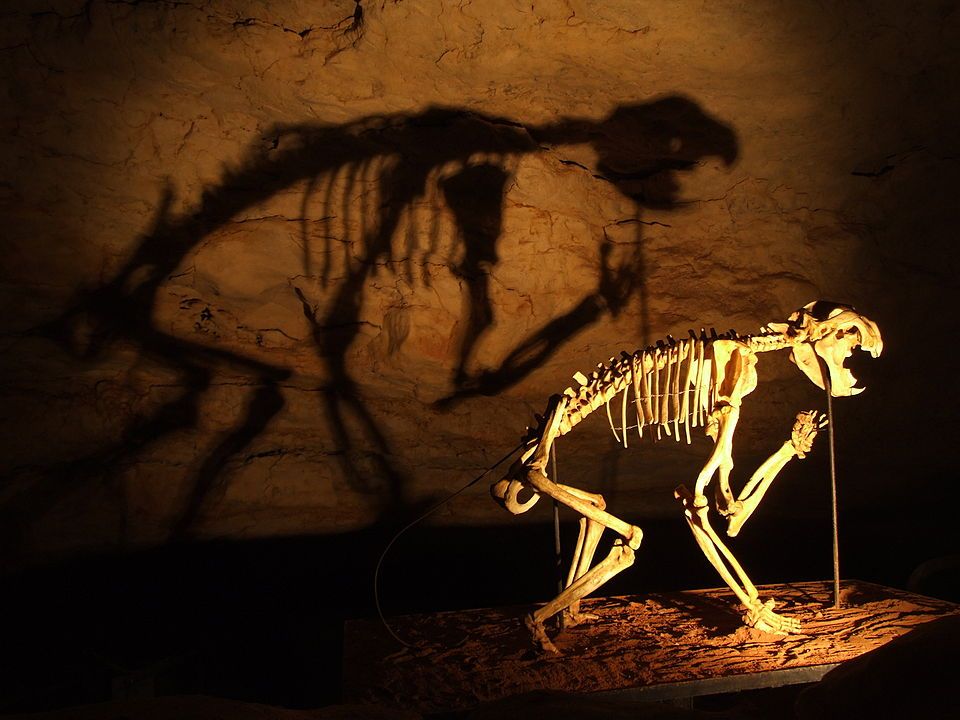
Tobias Andermann and his co-authors expect human pressure on other species to continue in their study. However, he does not agree with Paul Ehrlich's conclusion that the sixth mass extinction is already a reality.
"No, we are not there yet. But if the pace continues as it has over the past centuries, there will be a mass extinction at some point."
Then current humans are not the worst...
If the imaginative "overkill" idea is correct, that tens of thousands of hunter-gatherers actually - directly or indirectly - managed to exterminate the largest mammals that walked the earth, it would have an unexpected consequence. It would overturn the notion that modern humans are the worst marauders in Homo sapiens history.
Further on in history, there are clearer examples of human destruction. As people settled on islands in the Pacific Ocean between 3,500 and a few hundred years ago, enormous numbers of bird species disappeared, possibly as many as 2,000. Species on isolated islands are at a much higher risk of extinction than those on the mainland.
Another astonishing case is the passenger pigeon. In the early 1800s, there were several billion of these birds in North America. The last passenger pigeon died in a zoo in Cincinnati in 1914 after more than a century of horrific hunting pressure.

Around the same time, unrestrained bison hunting took place on the same continent. The collapse was halted just in time. When the bison was most pressured, only 400 individuals remained. By then, 60 million of the mighty grass-eater had been slaughtered. Recovery began in 1905 when the New York Zoo created an association for bison conservation, later supported by President Theodore Roosevelt. Today, there are about 400,000 bison, most of them in protected areas.
Similarly, with whales. When they were hunted most intensively in the 19th century, it was largely to "extract" fuel, namely whale oil for lamps. When whale populations began to shrink alarmingly, the main concern was that the world would run out of fuel, not that a fantastic category of species was disappearing. Then came electricity, and the reason for hunting whales for fuel disappeared. However, the hunt continued for meat until the international ban in 1986. Since then, most whale species have recovered.
Hypothesis and result
Hypothesis: Humans were significantly worse for animals and nature in the past than they are today
- True. (However, the hypothesis mainly applies to residents of civilizations, not indigenous peoples.) In our opinion, this is a main reason why a sixth mass extinction will never become a reality.
What conclusions can we draw?
So, what conclusions can we draw from all these facts, estimates, and opinions?
It is indisputable that the populations of a large number of species have shrunk as humanity has left a greater footprint on the Earth's surface. However, the rate of decline has begun to slow down. It is documented that around 900 species, of which 350 are vertebrates, have gone extinct in the past 400 years.
By common definition, it is clear that a sixth mass extinction is not taking place on Earth. With that established, however, a quagmire of trends and data awaits, which can be toned down or emphasized depending on their direction.
At its core, as in many other cases, it is a matter of disposition. If one is a pessimist and downplays improvements and emphasizes everything that can go wrong, it may seem perfectly reasonable to decide, like Paul Ehrlich, that we are already in a sixth mass extinction.
If one is an optimist and focuses on trends that have turned or slowed down and trusts that people's desire to preserve nature is genuine, one can feel confident that a sixth mass extinction will not occur. We will be able to live side by side with all the fantastic biodiversity on this planet, even when our species reaches its expected peak of ten billion.
The sixth mass extinction works well in headlines
The sixth mass extinction is primarily a headline-friendly term that can be used to draw attention to a problem. The problem itself is very real, but it is quite possible that its peak is behind us.
At the beginning of the last century, there were two billion people, who already had the capacity to kill animals and plants on an industrial scale. Animals, especially those that could be eaten or used for fur, were seen more as natural resources than as living beings. Some were considered dangerous, and their extinction was seen as a blessing. Plants were even more objectified.
Somewhere after World War II, the view of nature shifted from being a powerful adversary for us to conquer to something beautiful and fragile that we could actually threaten. Perhaps it had to do with the shocking insight the war gave us about our capacity for destruction.
In the 1960s, Rachel Carson's book Silent Spring was published, and the environmental movement was awakened in earnest. And that is the path we are on today. Today, there are almost seven times as many people as there were 150 years ago, but a slaughter of 60 million bison, as in North America in the 19th century, is no longer conceivable.
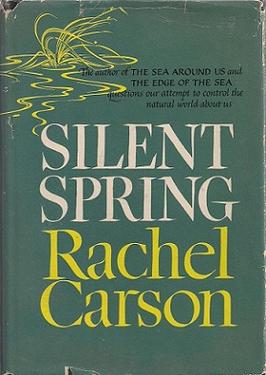
In the misanthropic nature conservation debate, it is said that it is now the first time in Earth's history that a single species, humans, is responsible for a mass extinction of other species. But it is equally true – and increasingly so with heightened awareness – that it is the first time a species actively protects and saves other species.
The nature conservation efforts of recent decades show that when humans understand that they are destroying and therefore retreat, nature can recover quickly and strongly. North America and Europe are the best examples so far. Today, there are more mammals in Europe than in the past 8,000 years.
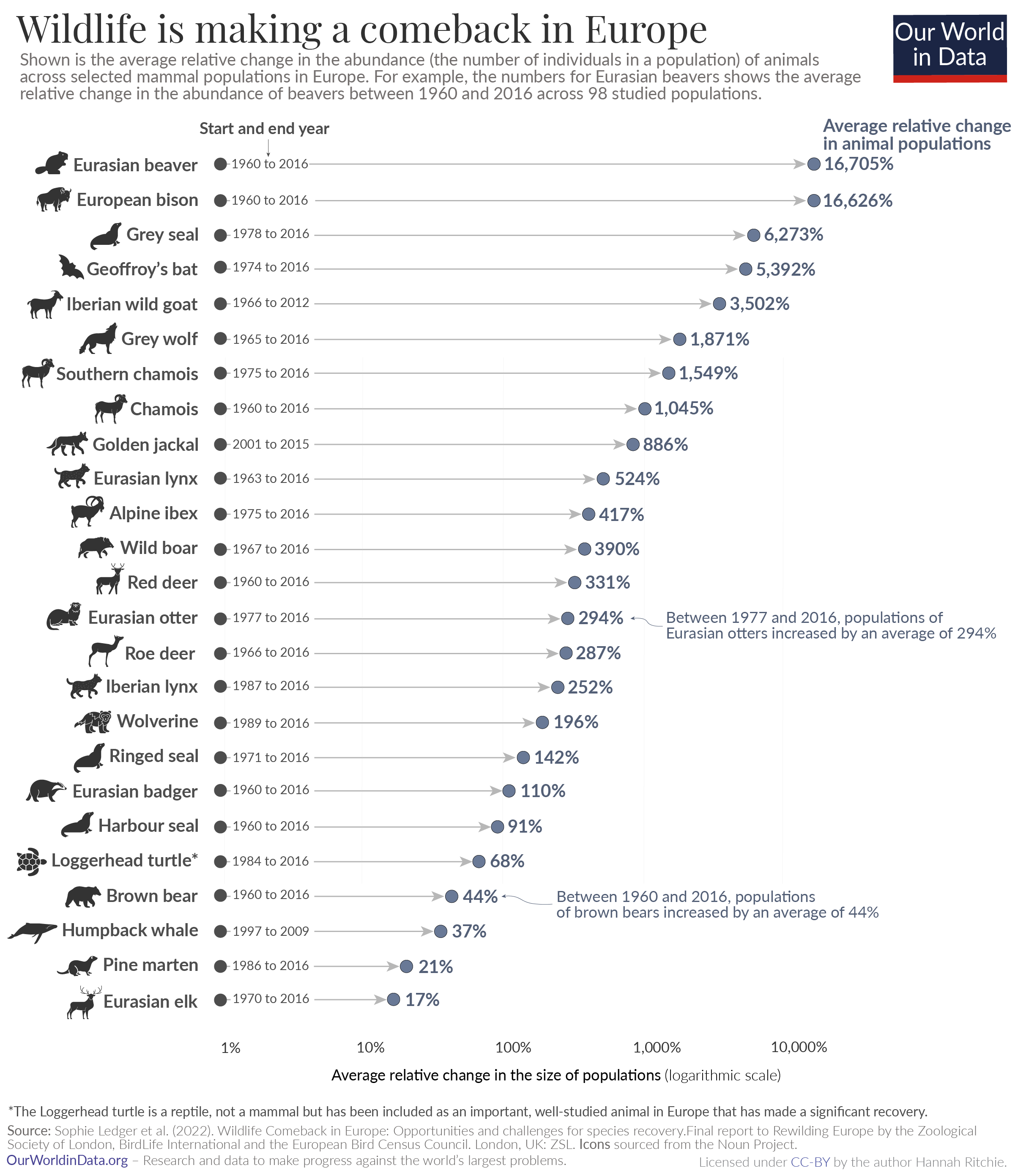
According to an American study, 291 species would have disappeared from the US since 1973 if it were not for the conservation laws that were put in place at that time. The same legislation has allowed 39 species to fully recover on American soil during the same period.
An entirely unintentional but very clear case is the exclusion zone around Chernobyl, a 2,800 square kilometer area, which after nearly 40 years without human interference has become a haven for lynx, European bison, deer, rodents, and various birds. The zone is now a natural experiment to test nature's ability to recover.
Now it is time for Asia, Africa, and South America to succeed as well or better in protecting animals and plants. There are already many good examples. A few include: the tiger, snow leopard, oryx, Yangtze dolphin, panda, black rhino, greater one-horned rhino, mountain gorilla, golden monkey, and Christmas Island's red crab.
Many researchers are concerned that people would neglect to protect nature if they heard that talk of mass extinction is an exaggeration. They also seem to believe that the perception - that alarms are inflated - is strong and dominant, which shapes their articles on the subject.
Warp News and our partner The Progress Network have a different view. We argue that alarms completely dominate media coverage. At the same time, we believe that most people can think for themselves and also hold more than one thought in their head at the same time. A report on the situation that is as objective as possible is likely to inspire confidence and does not affect people's desire to protect nature at all.
An international survey conducted in 2019 shows a strong willingness to care for animals and plants, and the extinction of species concerns virtually everyone. This applies to both the affluent part of the world and poorer countries.
But what is an appropriate number of individuals of each species in a world where eight billion people coexist with millions of other species? That is a philosophical question. At the beginning of the last century, there were 200,000 lions and ten million elephants in Africa. Today, there are 25,000 and 450,000 respectively. Is this an unacceptably low number? Everyone must make their own assessment. IUCN's thresholds for when species are considered critically endangered are not absolute, but they are, of course, a good starting point.
Humans are not just mouths to feed but also wonderfully creative and constructive beings. The interaction between us and other species is not a zero-sum game.

Paul Ehrlich missed the green revolution, a brilliant example of how inventive humanity solves its problems. He admits it today, but he seems to see it as a disturbance he could not have foreseen when he predicted mass famine in the world within ten years in 1968. When I insist on a more optimistic approach during the interview with the Stanford professor and ask him to point out hopeful tendencies, he does not say "human wisdom and creativity" but "worried young people".
"The question is whether they can change things quickly enough."
Hypotheses and results: Summary
So, this is the result of our deep dive:
Hypothesis: For the past 50 years, species populations are no longer shrinking in wealthy countries. In many cases, they are increasing. Recently, populations have also stopped declining in poor countries.
- Not entirely accurate. Populations stopped shrinking only about a decade ago in most regions, but not all.
Hypothesis: What is called species extinction is almost entirely about shrinking populations.
- Mostly accurate. Media, environmental agencies, and even some researchers often describe decreased populations in terms of extinction.
Hypothesis: The extremely large number of species said to go extinct continuously comes from theoretical models of insects and even smaller organisms assumed to disappear.
- Accurate. Since Norman Myers' book The Sinking Ark from 1979, spectacular assumptions have gained attention, suggesting that tens of thousands, perhaps even more, species go extinct each year. The numbers are impossible to verify.
Hypothesis: Among larger species, few extinctions in modern times have actually been documented.
- Generally accurate. The words "few" and "modern times" need to be more clearly defined. In a geological sense, even what we see as "few" (less than one percent of all vertebrates in 500 years) is a high rate.
Hypothesis: Humans were much worse for animals and nature in the past than today.
- Accurate. (However, the hypothesis mainly applies to inhabitants of civilizations, not indigenous people.) In our opinion, this is a key reason why a sixth mass extinction will never become a reality.
Hypothesis: Many species thrive in urban environments.
- Accurate. There are numerous studies showing that many animals and plants have successfully made cities their habitats.
A problem we can solve
Let us use the extensive knowledge we now have to continue to protect pressured animal and plant species. We can feel confident that we can manage it, as a closer examination shows that the problem is more manageable than it is presented.
Finally: John Kerry was wrong. At least he should have been more specific about such a serious matter. Perhaps he meant individuals, not species? If so, he was actually wrong in the other direction.

Anders Bolling
This investigation is a collaboration between Warp News and The Progress Network
You can sign up - for free - for both of our newsletters here.

By becoming a premium supporter, you help in the creation and sharing of fact-based optimistic news all over the world.
